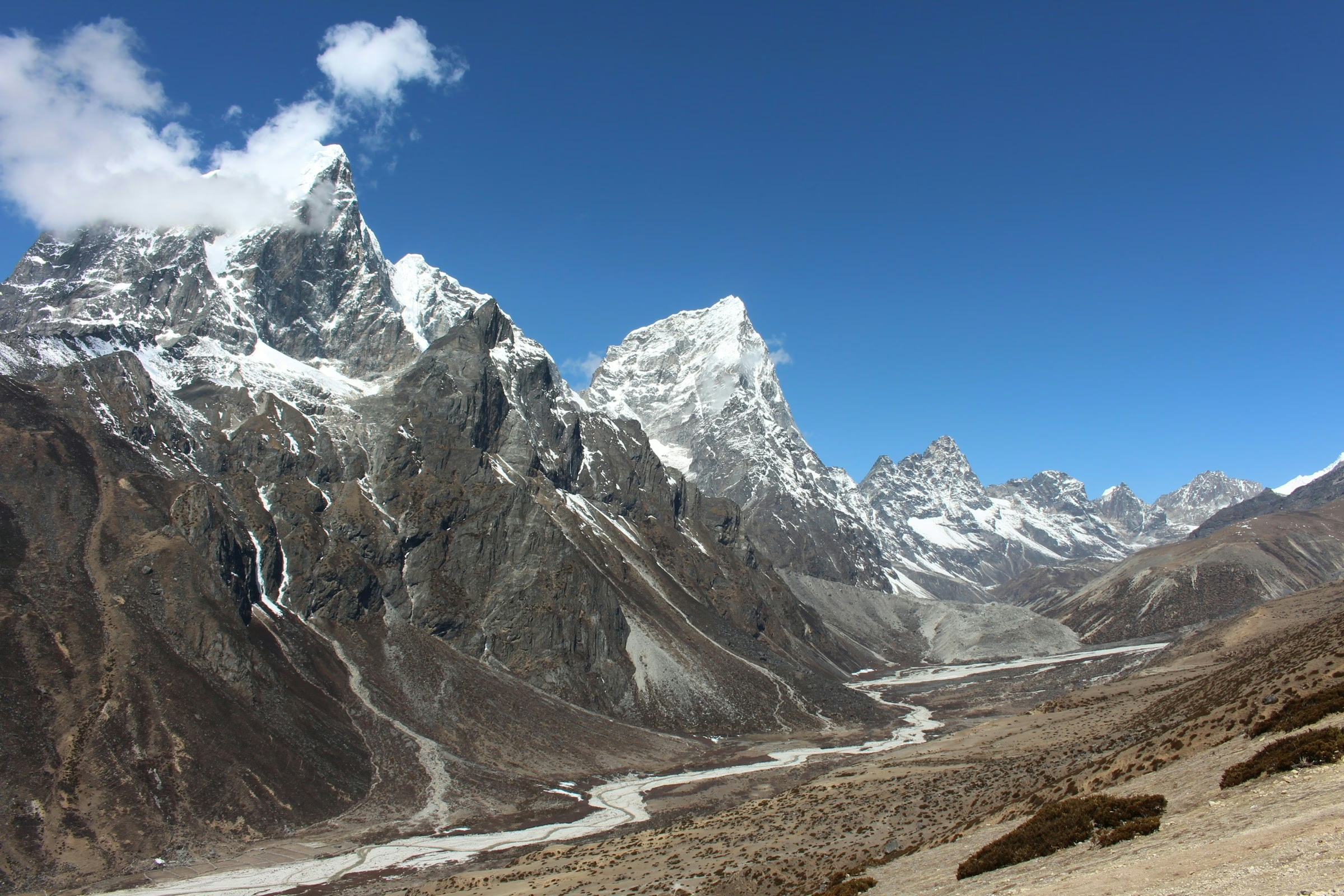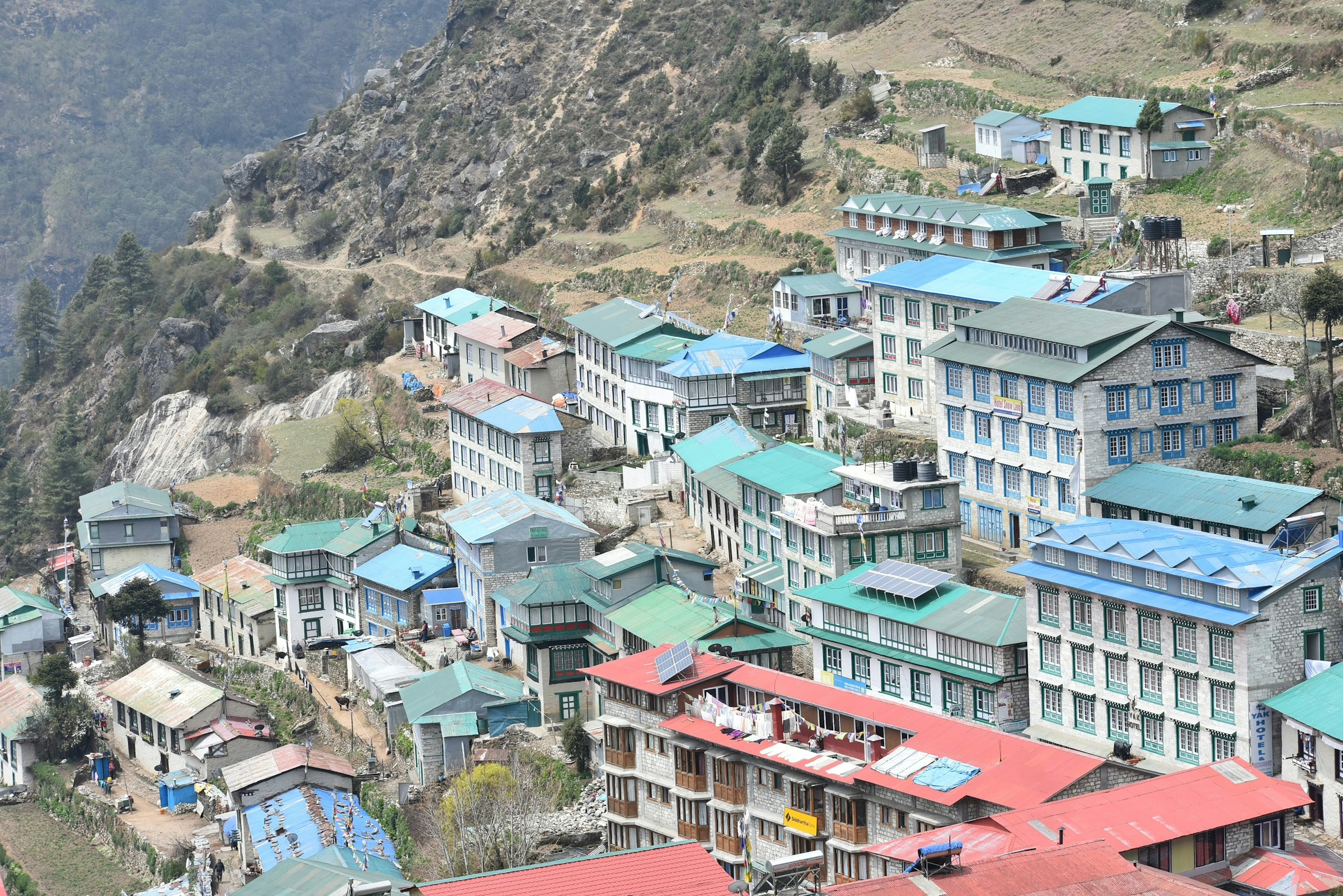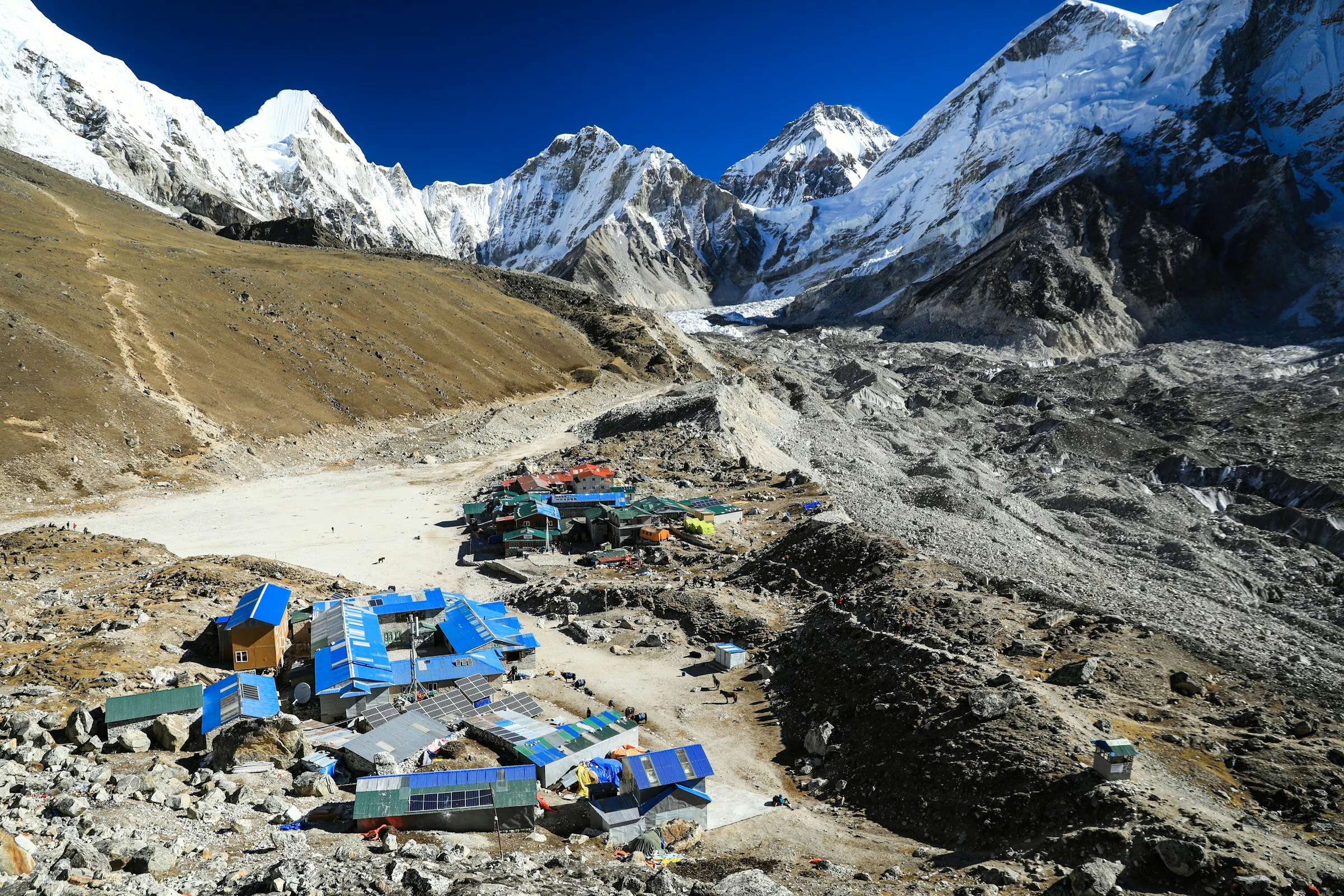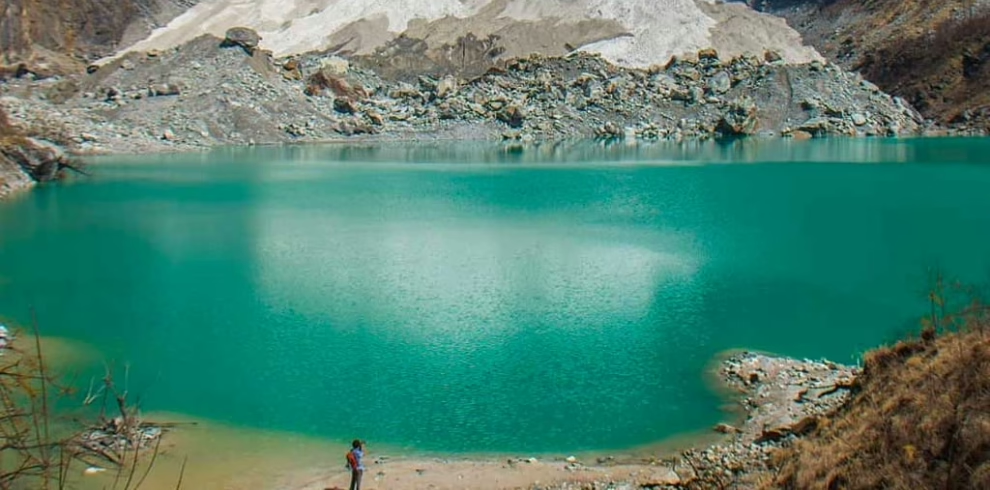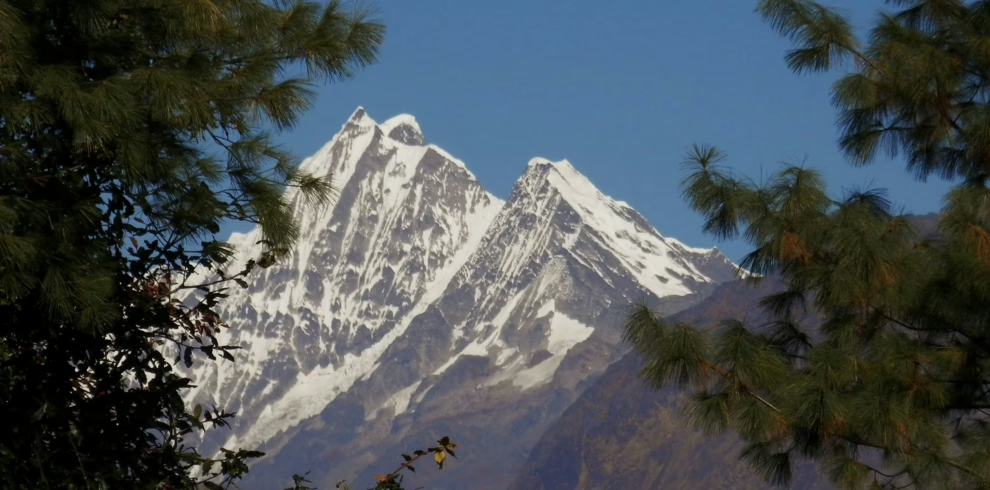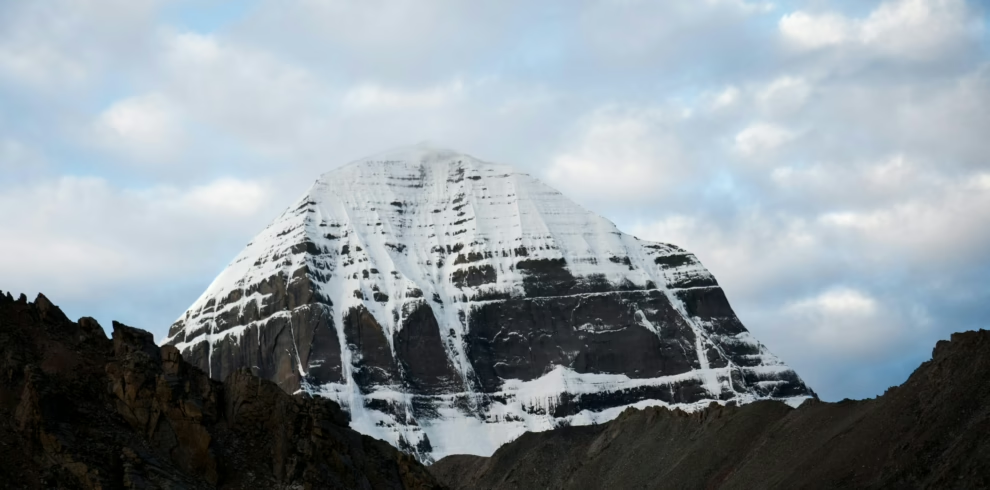Embark on the adventure of a lifetime with the 12-day Everest Base Camp Trek—one of the world’s most iconic trekking journeys. This trek offers awe-inspiring views of Mount Everest, the world’s tallest peak, along with a panoramic display of other majestic Himalayan giants. Standing at 8,848 meters, Mount Everest’s imposing presence draws trekkers from all over the globe, eager to witness its frozen beauty and for climbers, to challenge its towering heights. No wonder Everest Base Camp is considered one of the world’s top trekking destinations.
Your journey begins with a thrilling scenic flight from Kathmandu to Lukla. From there, we follow a well-trodden path leading to the vibrant Sherpa village of Namche Bazaar, and then to the tranquil Buddhist monastery of Tyangboche. Here, you’ll experience peace and breathtaking views of Everest (8,848m), Lhotse (8,501m), Cho Oyu (8,153m), Makalu (8,463m), and the stunning Ama Dablam (6,856m), among others. Along the 12-day trail, you’ll traverse glaciers and rugged terrain, all while drawing closer to the base of Everest itself—an experience that will stay with you forever.
12 days / 11 nights Everest Base Camp trip
Chase Sunrises in the Everest Region
Highlights
- Panoramic sunrise views of Mount Everest, Pumori, Nuptse, Lhotse, and more from Kalapathar.
- Breathtaking sights of the Khumbu Icefall and glacier from Everest Base Camp.
- Visit Buddhist monasteries in Namche, Khumjung, Tengboche, and Pangboche.
- Stunning views of snow-capped peaks such as Lobuche East, Kangtega, Ama Dablam, Lobuche West, Thamserku, and Taboche Peak.
- Exciting ascent to Everest Base Camp, at the foot of the world's highest peak.
- Trek through the remote, rugged terrain of the Khumbu region.
- Explore the rich wildlife and rare species of the Everest region.
- Immerse in the cultural history of the Khumbu, with visits to Tibetan Buddhist temples and traditional villages.
- Experience the warmth and hospitality of Sherpa-run teahouses and lodges.
Itinerary
After breakfast, you'll ride a tourist bus to Ramechaap's domestic airport for your scheduled morning flight to Lukla—the gateway to the 12-day Everest Base Camp Trek. Enjoy a 30-minute scenic flight over the stunning Himalayan landscape before landing at Tenzing-Hillary Airport. Upon arrival, you'll meet your porters and trekking crew, then begin your trek. After a few hours of hiking, you'll reach Phakding. Today’s short walk helps with acclimatization. If you're interested, you can also visit a nearby monastery.
On the second day of your 12-day Everest Base Camp trek, you’ll hike through scenic pine forests along the Dudh Koshi River, crossing several suspension bridges—including the famous Hillary Suspension Bridge. Along the way, enjoy views of Mount Thamserku (6,618m) as you pass through the villages of Benkar and Monjo. You'll then reach the Sagarmatha National Park entrance checkpoint. After passing the last village of Jorsale, the trail ascends through forested terrain and across more bridges, eventually reaching the confluence of the Dudh Koshi and Bhote Koshi Rivers. After a steep two-hour climb, you'll catch your first glimpse of Mount Everest behind the Lhotse and Nuptse ridges. From there, it’s about another 90 minutes of hiking to Namche Bazaar—the gateway to Everest and the main trading hub of the region.
Acclimatization is essential when trekking at high altitude, which is why today is set aside for rest and adjustment on the 12-day Everest Base Camp itinerary. However, staying active is important, so instead of remaining idle, you can take a short hike to Thame or Khunde, or simply explore Namche Bazaar. As the main hub of the Khumbu region, Namche offers amenities like government offices, internet cafes, ATMs, restaurants, and shops. Your guide will also take you to the Tourist Visitor Center near the Sagarmatha National Park headquarters, where you can learn about the region’s flora, fauna, Sherpa culture, and the first Everest climbers.
The trek to Tengboche is dusty and winding, but the panoramic views from the monastery make it worthwhile. With few steep ascents or descents, you'll have ample opportunity for photography. Capturing images of stupas, prayer flags, Mani walls, the striking Ama Dablam (6,812 m), and the iconic Tengboche Monastery is highly rewarding.
The trek from Tengboche to Dingboche begins with a visit to the region’s oldest Buddhist monastery. The trail then winds through alpine forests to Upper Pangboche, followed by the villages of Shomare, Orsho, and Tsuro Wog. As you ascend through the Khumbila Khola Valley to a ridge, you'll be rewarded with stunning views of Taboche (6,495m), Thamserku (6,608m), Ama Dablam (6,812m), Nuptse (7,861m), Cholatse (6,440m), Lhotse (8,516m), and more. The day’s trek ends at Dingboche after crossing the Imja Khola.
Today is your second acclimatization day, scheduled due to the increasing altitude. While the stunning views are a reward, rest is essential to prepare for the trek ahead. You can explore nearby villages like Chhukung and Imja or simply relax in Dingboche. For those feeling energetic, short hikes to Nagarjun Hill (5,100m) or Chhukung Ri (5,546m) are great options. From the top of Nagarjun Hill, you’ll enjoy panoramic views of Mt. Makalu, Mt. Lobuche, Thamserku, Ama Dablam, and more.
The trek begins with a climb through the Khumbu Khola Valley toward Duglha, where the valley narrows near Dusa. The trail is challenging, with large boulders and yaks often passing by at high altitude. Along the way, you'll see memorials adorned with prayer flags and stones, honoring climbers who lost their lives on Mt. Everest. The trail then intersects with the route to Gokyo Lakes and Cho-La Pass. You’ll also enjoy views of peaks like Khumbutse (6,636m), Lingtren (6,749m), and Pumori (7,161m). The rocky terrain can be tiring as you approach Lobuche, a small settlement with only a few lodges.
Today marks the most significant day of your 12-day Everest Base Camp Trek. The trail to Gorakshep follows the edge of the Khumbu Glacier, passing the well-known pyramid signpost. A steady climb leads to Thangma Riju, offering a 360-degree panorama of snowcapped peaks. Upon reaching Gorakshep, you’ll be greeted by stunning views of the surrounding mountains, including the summit of Everest. From there, you’ll hike to Everest Base Camp. After enjoying the breathtaking scenery, you’ll return to Gorakshep for an overnight stay.
Today, you’ll reach the highest point of the 12-day Everest Base Camp Trek. An early morning start takes you to Kala Patthar, one of the best viewpoints on the route. From here, you’ll witness the first light of day illuminating Mount Everest, along with striking views of peaks like Lingtren, Khumbutse, and Changtse. As Everest emerges between the West Shoulder and Nuptse, you’ll have time to capture unforgettable photos. After enjoying the scenery, you’ll return to Gorakshep for breakfast, then begin your descent to Pheriche for an overnight stay.
Today, you'll enjoy an easy walk down to lower altitudes. Following the same route back to the terminal moraines at Dughla, you’ll pass through the scenic Sherpa villages of Pheriche, Orsho, and Shomare. Continuing on, you'll reach Pangboche, home to the region’s oldest monastery, which is said to house the scalp and bones of the legendary Yeti. After leaving the mountains behind, you'll descend through Tengboche Monastery (3,860m) and head toward Namche.
On the final day of your 12-Day Everest Base Camp Trek, the trail descends steeply. Walk slowly and steadily as your legs navigate the rocky terrain. After crossing the suspension bridges over the Dudh Koshi River, the path levels out. A light breeze will warm you as you pass through beautiful pine and rhododendron forests, eventually reaching Lukla for an overnight stay.
Today, you’ll fly back to Kathmandu after your mountain journey. Take a 35-minute morning flight from Lukla to Tribhuvan International Airport. Upon arrival in Kathmandu, you can relax or enjoy some last-minute shopping.
Includes/Excludes
Cost Includes
- Pickup from Kathmandu International Airport on your arrival date and time.
- Flight to Lukla from Kathmandu or Ramechhap, including airport transfers.
- All necessary permits for the 12-day Everest Base Camp trek.
- 11 nights’ accommodation during the trek (twin-sharing).
- Purified drinking water (Ef-Chlor water purification tablets).
- Three daily meals (breakfast, lunch, and dinner) during the trek.
- Duffel bag (provided if you hire a porter to carry your luggage).
- Sleeping bag rated for temperatures as low as -20°C.
- First aid kit and an eco-trained, English-speaking guide (Lukla to Lukla), including their insurance, salary, food, equipment, and accommodations.
- Flight from Lukla or Ramechhap back to Kathmandu, including transportation.
- Achievement certificate (if requested).
- Farewell dinner at a Nepali restaurant in Thamel before departure.
- Free luggage storage at Green Lotus Trekking store during the trek.
Cost Excludes
- International airfare, Nepal visa fee, and insurance.
- Meals and accommodation in Kathmandu.
- Porter service (if you choose to hire a porter, it costs USD 220 per porter, who can carry up to 25 kg). You can add this option when booking.
- Additional expenses during the trek, such as hot showers, drinks, extra meals, Wi-Fi or data, device charging, and upgraded accommodations.
- Tips for the staff (gratuities are expected).
FAQs
Yes. Flights to Lukla have a baggage limit of 15 kg per person—10 kg for checked luggage and 5 kg for hand luggage.
Yes, but availability and cost vary. In off-season (winter), you may find free charging in teahouses with low occupancy. However, during peak seasons, you may be charged up to $5 per hour to charge your devices.
Yes, solo trekking is allowed. However, we don’t recommend it due to safety risks. If you don’t want to hire a guide, consider hiring a local porter for support and safety, especially if you plan to take alternate routes or high passes.
Spring (March–May) and autumn (October–November) are ideal for trekking due to clear weather and scenic views. Winter is possible if you’re prepared for cold, while monsoon season is less favorable due to rain and poor visibility. Helicopter tours are possible year-round except during heavy rains.
Yes. Thanks to Everest Link, Wi-Fi is available at Everest Base Camp and over 200 locations along the trail.
You can store it at our office or at your hotel in Kathmandu—most hotels offer secure storage for guests.
Begin training at least three months in advance with activities like running and walking. Get a medical check-up to ensure you’re in good health and have normal blood pressure to reduce altitude-related risks.
Stay well-hydrated, eat properly, get adequate rest, and follow acclimatization schedules. If symptoms arise, use altitude sickness medication and descend if needed.
Trekking is possible in monsoon (June–August), but flights to Lukla are often canceled due to poor weather. Instead, you’ll need to drive to Salleri and begin your trek from there. Due to frequent rain and limited visibility, monsoon is not an ideal time to trek.
Yes, most teahouses offer vegetarian meals. We recommend choosing vegetarian options to reduce the risk of foodborne illness, as meat may not be stored hygienically at high altitudes.
The 12-day Everest Base Camp trek is moderately challenging and adventurous. If you’re physically fit and enjoy a good challenge, this trek will be a rewarding experience. Our itinerary is designed to ensure gradual acclimatization, minimizing the risk of altitude sickness. However, we recommend checking your fitness and reviewing the itinerary before the trek.
Green Lotus Trekking has specialized in the Everest Base Camp trek since its inception, offering the best prices and services. Our 12-day package is the most popular among our offerings, providing excellent value. The trek includes tea house and lodge accommodations, and our experienced Sherpa guides and porters will support you throughout, catering to your needs and ensuring a smooth journey.
To help you prepare, our Everest Base Camp Trek Map offers detailed elevation information for various landmarks, allowing you to plan your trek effectively. With this map, you can make informed decisions, ensuring a safer and more enjoyable adventure. Start your trek with confidence, knowing exactly what to expect along the way.
Benefits of Booking the 12-Day Everest Base Camp Trek with Us:
- Airport pickup and drop-off (international and domestic)
- Free Everest Base Camp Trek map
- Oximeter to monitor blood oxygen levels
- Medical kit for emergencies
- Free excess luggage storage at Green Lotus Trekking store during the trek
What to Expect from the 12-Day Everest Base Camp Trek:
The 12-day Everest Base Camp Trek begins with a flight from Kathmandu to Lukla, one of the world’s most thrilling airports. From Lukla, you’ll enter Sagarmatha National Park, a UNESCO World Heritage Site rich in alpine greenery. The park is home to rhododendron, blue pine, birch, juniper, and bamboo forests, which you’ll pass through on your way to Everest Base Camp.
The trek offers stunning views of the surrounding mountains. A highlight of the journey is a visit to Kala Patthar, where you’ll experience one of the best views of Mount Everest. The region is also known for its Tibetan Buddhist Sherpa culture. You’ll have the opportunity to explore Tengboche Monastery and learn about the area’s rich traditions.
Is the 12-Day Everest Base Camp Trek Right for You?
The Everest Base Camp trek requires an adventurous spirit and a willingness to adapt. Conditions in remote areas can be unpredictable, so flexibility and a positive attitude are key. While you won’t encounter the same comforts as in developed areas, the experience offers unparalleled rewards.
This trek is ideal for those new to hiking but in good physical condition. You should be prepared to walk 4-6 hours each day, with some days being longer. The key is to pace yourself, walk comfortably, and enjoy the journey at a steady rhythm.
How to Prepare for the 12-Day Everest Base Camp Trek:
The 12-day Everest Base Camp trek is a condensed version of the standard trek, so preparation is essential. To get ready, practice hiking by completing 4-5 treks in advance. Engage in aerobic exercises such as jogging, cycling, or swimming to improve endurance.
You can also use elevation masks during workouts to build stamina. It’s important to fuel your body with a balanced diet, focusing on protein and carbohydrates to build strength. In addition to physical training, mental preparation is crucial. Stay calm in the face of challenges and approach the trek with a positive mindset. With both physical and emotional preparation, you’ll be well-equipped to enjoy the trek and complete it comfortably.
Useful Information for the 12-Day Everest Base Camp Trek
Best Time to Hike:
The best seasons for trekking to Everest Base Camp are spring (February to May) and autumn (September to December). Spring offers mild temperatures and clear mountain views, with the added beauty of blooming flowers. Autumn, with daytime temperatures between 14-20°C and colder nights (-5 to -10°C), is also ideal for hiking.
Food During the Trek:
High-altitude hiking requires a diet rich in carbohydrates and protein. Local dishes like Dal Bhat, a nutritious Nepalese meal with lentils and rice, are excellent. Other options include momos (dumplings), noodles, sandwiches, and seasonal vegetables. Avoid non-vegetarian options and dairy products, as they may be less hygienic at high altitudes. Instead, opt for hot beverages like ginger tea, garlic soup, and lemon tea for warmth and hydration.
Accommodation:
We provide comfortable accommodations at budget-friendly teahouses and lodges along the trek. Rooms typically include single beds, electric blankets, hot showers, and beautiful mountain views. If you are traveling solo, we can arrange private rooms.
Trek Difficulty:
This 12-day trek is moderate in difficulty, with daily hikes of 5-6 hours. The terrain is steep, with various obstacles like cliffs and deep valleys. To complete the trek successfully, good physical fitness is essential. Altitude sickness is a risk due to the high elevation, so it’s important to acclimatize properly.
Travel Insurance:
Travel insurance is mandatory for trekkers, especially in mountainous areas. We recommend comprehensive insurance that includes emergency helicopter rescue, medical evacuation, and coverage for personal injury or illness.
Altitude Sickness and Remedies:
Altitude sickness is a common risk on high-altitude treks. To prevent it, gradually acclimatize, stay hydrated, and avoid alcohol and smoking. Acetazolamide (Diamox) may be used to aid acclimatization, but if symptoms worsen, immediate descent is necessary.
Packing List:
Essential items include a -20°C sleeping bag, duffel bag, thermal clothing, waterproof jacket, hiking boots, woolen hat, water bottles, and a first aid kit. For a detailed list, refer to our recommended packing guide.
Safety and Satisfaction:
Our 12-day trek is fully guided by experienced, government-trained Sherpa guides. For your safety, guides carry necessary gear and a first-aid kit. In case of altitude sickness or emergencies, we arrange helicopter rescues, and we recommend having travel insurance that covers evacuation.
Booking Procedure:
To book the 12-day Everest Base Camp trek, a 10% deposit is required. This secures your accommodations, guides, permits, and transportation. The balance can be paid upon arrival. Please provide a copy of your passport and travel insurance at booking.
Lukla Flight and Weather Conditions:
Flights to Lukla are often canceled due to weather. If this happens, the trek may be shortened. Helicopter flights are available as an alternative but come with additional costs ($300–$500 per person), and availability depends on weather conditions. The weight limit for luggage on flights to Lukla is 10kg for main luggage and 6–8kg for hand luggage.



